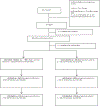Effect of supplementation with a lipid-based nutrient supplement on the micronutrient status of children aged 6-18 months living in the rural region of Intibucá, Honduras
- PMID: 24628577
- PMCID: PMC7213595
- DOI: 10.1111/ppe.12117
Effect of supplementation with a lipid-based nutrient supplement on the micronutrient status of children aged 6-18 months living in the rural region of Intibucá, Honduras
Abstract
Background: Lipid-based nutrient supplements (LNS) have been effective in the treatment of acute malnutrition among children. We evaluated the use of LNS supplementation for improving the micronutrient status of young children.
Methods: A 12-month randomised controlled trial was conducted among children aged 6-18 months living in Intibucá, Honduras. Communities (n = 18) were randomised into clusters matched by poverty indicators (9 intervention, n = 160 and 9 controls, n = 140). Intervention participants received LNS. All children received food vouchers and nutrition education. Primary outcomes included measures of micronutrient status: at baseline, 6 and 12 months' blood were collected for assessment of folate, iron, zinc, riboflavin, and vitamin B12 status; haemoglobin was measured every 3 months; and dietary and anthropometry collected monthly. Longitudinal analyses were based on intent to treat and LNS adherence. Generalised estimating equations were used in the estimation of generalised linear regression models specified for the data.
Results: At 6-month follow-up, children in the intervention group had a lower proportion classified as deficient for B12 (43.6%) compared with the control (67.7%; P = 0.03). The intervention group had a higher mean concentration for folate at 6 months (P = 0.06), and improvements continued through 12 months for folate (P = 0.002) and vitamin A deficiency (P = 0.03). This pattern of results, with improved significance, remained in subanalysis based on LNS adherence.
Conclusion: These data demonstrate that LNS improved select micronutrient status in young non-malnourished Honduran children.
Keywords: Honduras; child undernutrition; lipid-based nutrient supplements; micronutrients; prevention; randomised controlled trial.
© 2014 John Wiley & Sons Ltd.
Conflict of interest statement
Conflict of Interest
The authors have no conflicts of interest to declare.
Figures
References
-
- de Onis M, Blossner M, Borghi E. Prevalence and trends of stunting among pre-school children, 1990–2020. Public health nutrition. January 2012;15(1):142–148. - PubMed
-
- Millenium development goals report 2010, United Nations. [computer program]. New York: United Nations; 2010.
-
- Allen LH, Peerson JM, Olney DK. Provision of multiple rather than two or fewer micronutrients more effectively improves growth and other outcomes in micronutrient-deficient children and adults. The Journal of nutrition. May 2009;139(5):1022–1030. - PubMed
-
- Kuusipalo H, Maleta K, Briend A, Manary M, Ashorn P. Growth and change in blood haemoglobin concentration among underweight Malawian infants receiving fortified spreads for 12 weeks: a preliminary trial. Journal of pediatric gastroenterology and nutrition October 2006;43(4):525–532. - PubMed
Publication types
MeSH terms
Substances
Grants and funding
LinkOut - more resources
Full Text Sources
Other Literature Sources
Medical


